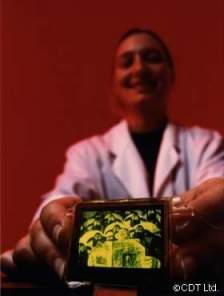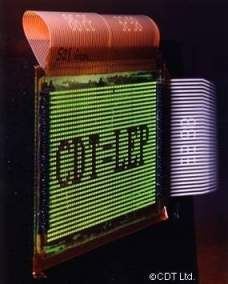Flat-packed technology - part 1
What do a pop group, a peer of the realm, a Japanese electronics company, a chemical manufacturer and a
bunch of Cambridge scientists have in common? Answer: they are
all involved in a technology company that will soon bring us the
world's first full-colour plastic TV screen.
The story began in the 1970s when polymer scientists
discovered that some polymers could surprisingly carry a
current. The possibilities of plastic wires and lightweight
circuitry were obvious although not immediately practical but
one additional effect was that a small few of these materials
when specially prepared could glow weakly in ultraviolet light
or when carrying a  current. The idea of using them in displays began to emerge. At this
time, however, liquid crystal displays were becoming fashionable with
manufacturers of the new digital watches and calculators, and were
displacing inorganic light-emitting diodes providing the cash to develop
LCDs to the point at which they would be fast and slick enough for
computer technology. Countless laptop computers around the world now use
LCD displays.
current. The idea of using them in displays began to emerge. At this
time, however, liquid crystal displays were becoming fashionable with
manufacturers of the new digital watches and calculators, and were
displacing inorganic light-emitting diodes providing the cash to develop
LCDs to the point at which they would be fast and slick enough for
computer technology. Countless laptop computers around the world now use
LCD displays.
The trouble with LCDs though is that they although liquid crystals are
now rather well understood actually incorporating them into devices is
still a rather complicated process so they are expensive to manufacture
and control. The construction of displays, is awkward, requiring careful
sandwiching between two layers of transparent materials one of which has
to be a perfectly aligned polarising layer. Once assembled, LCDs are
fragile, can often only be viewed
within a very narrow angle and then only in perfect ambient light. Many
technologists feel that an easier to make and more robust alternative
system could usurp LCDs. Which is where the glowing plastics come in.
Plastic fantastic
The conducting polymers studied in the 1970s and 1980s were simple
affairs. Simply a strand of carbons linked by conjugated double bonds.
Appearances are often deceptive though. The conjugation can endow the
polymer with excitable electrons give them a kick with UV or an electric
current and they become agitated, leaping to higher energy levels, when
they drop back down photons are ejected. If these photons have the right
wavelength we see a glow.
 This remarkable property was not lost on
bright sparks at the Cavendish Laboratory in Cambridge.
Physicists Jeremy Burroughes, Donal Bradley and Richard Friend
figured that electroluminescent polymers might be used to make
tiny light-producing electronic components. The fact that they
would be plastic might make them less fragile than inorganic
semiconductor materials chipped off synthetic crystals. These
devices would be much lighter and could even be bent they would
be so tough. The idea of packing such devices into an array with
a means to control their glow electronically would produce a
simple display that could effectively be any shape or size you
like, from pocket TV to 360-degree cinematic surround screen, from lightweight and
comfortable virtual reality headsets to huge video advertising hoardings
in Piccadilly Circus. The commercial implications were enormous...
This remarkable property was not lost on
bright sparks at the Cavendish Laboratory in Cambridge.
Physicists Jeremy Burroughes, Donal Bradley and Richard Friend
figured that electroluminescent polymers might be used to make
tiny light-producing electronic components. The fact that they
would be plastic might make them less fragile than inorganic
semiconductor materials chipped off synthetic crystals. These
devices would be much lighter and could even be bent they would
be so tough. The idea of packing such devices into an array with
a means to control their glow electronically would produce a
simple display that could effectively be any shape or size you
like, from pocket TV to 360-degree cinematic surround screen, from lightweight and
comfortable virtual reality headsets to huge video advertising hoardings
in Piccadilly Circus. The commercial implications were enormous...
 current. The idea of using them in displays began to emerge. At this
time, however, liquid crystal displays were becoming fashionable with
manufacturers of the new digital watches and calculators, and were
displacing inorganic light-emitting diodes providing the cash to develop
LCDs to the point at which they would be fast and slick enough for
computer technology. Countless laptop computers around the world now use
LCD displays.
current. The idea of using them in displays began to emerge. At this
time, however, liquid crystal displays were becoming fashionable with
manufacturers of the new digital watches and calculators, and were
displacing inorganic light-emitting diodes providing the cash to develop
LCDs to the point at which they would be fast and slick enough for
computer technology. Countless laptop computers around the world now use
LCD displays. This remarkable property was not lost on
bright sparks at the Cavendish Laboratory in Cambridge.
Physicists Jeremy Burroughes, Donal Bradley and Richard Friend
figured that electroluminescent polymers might be used to make
tiny light-producing electronic components. The fact that they
would be plastic might make them less fragile than inorganic
semiconductor materials chipped off synthetic crystals. These
devices would be much lighter and could even be bent they would
be so tough. The idea of packing such devices into an array with
a means to control their glow electronically would produce a
simple display that could effectively be any shape or size you
like, from pocket TV to 360-degree cinematic surround screen, from lightweight and
comfortable virtual reality headsets to huge video advertising hoardings
in Piccadilly Circus. The commercial implications were enormous...
This remarkable property was not lost on
bright sparks at the Cavendish Laboratory in Cambridge.
Physicists Jeremy Burroughes, Donal Bradley and Richard Friend
figured that electroluminescent polymers might be used to make
tiny light-producing electronic components. The fact that they
would be plastic might make them less fragile than inorganic
semiconductor materials chipped off synthetic crystals. These
devices would be much lighter and could even be bent they would
be so tough. The idea of packing such devices into an array with
a means to control their glow electronically would produce a
simple display that could effectively be any shape or size you
like, from pocket TV to 360-degree cinematic surround screen, from lightweight and
comfortable virtual reality headsets to huge video advertising hoardings
in Piccadilly Circus. The commercial implications were enormous...